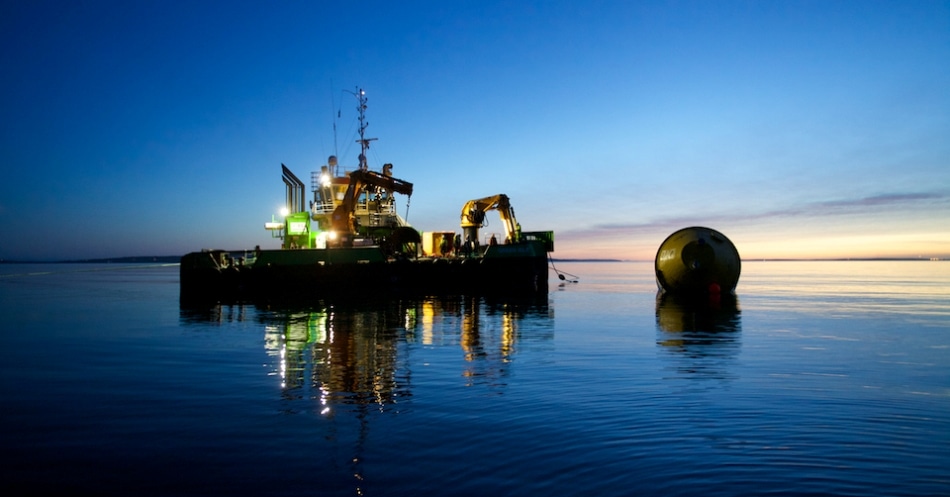Feb 19 2018
Accessibility of renewable energy to remote islands and coastal areas is the new aim of Europe. This is the steering force behind the investigation of a robust Swedish-designed wave energy conversion system in the North Atlantic.
 From KTH to the North Atlantic, a new wave energy conversion system is installed in the waters off Orkney, Scotland. (Image credit: Colin Keldie)
From KTH to the North Atlantic, a new wave energy conversion system is installed in the waters off Orkney, Scotland. (Image credit: Colin Keldie)
Motivated by the mechanics of the human heart, an innovative kind of wave energy conversion system created in Sweden is at present floating on the sea surface off Orkney, Scotland. It is being tested for loads, survivability, and performance in off-grid functioning, to verify the business case for full-scale application in target markets.
The study brought together research and industrial partners from Portugal, Scotland, Ireland, Norway, Sweden, and Germany, and has been funded by InnoEnergy, the Swedish Energy Agency, and Wave Energy Scotland with an investment of 6.5 million Euros. It has also been supported by the European Commission’s H2020 WaveBoost project, with an additional contribution of 4 million Euros.
Designed by CorPower Ocean AB, a Swedish startup, the C3 wave energy converter system is based on machine design research performed at KTH Royal Institute of Technology, Stockholm, and also control technology research at NTNU in Trondheim.
According to Patrik Möller, CEO of CorPower, the C3 can make the most of the complete spectrum of waves, generating five times more energy per ton when compared to other systems.
The sea waters close to Orkney are believed to offer some of the best wave and tidal energy sources across the globe, and the zone has become a sought-after place for the experimentation of renewable energy.
“We are seeing immense value in working in the Scottish ocean energy ecosystem, where we can benefit from lessons learned from previous wave projects,” stated Möller. “Working closely with the Orkney supply chain provides us with unique operational experience to the project, as they have deployed more ocean energy devices than anywhere else in the world.”
The C3 is referred to as a point absorber type system in the wave energy industry and includes a buoy that absorbs wave energy, and also a drivetrain that transforms the motion of the buoy into electric current. The unit has been developed based on patents obtained by Stig Lundbäck, a Swedish cardiologist, some of which are based on his investigations into heart pumping and control functions.
In order to transform the buoy’s linear motion into an energy-producing rotational motion, the system depends on a unique rack and pinion gearbox created at KTH. Conceptually, it functions similar to a rack and pinion steering system. When the steering wheel of a car is rotated, a pinion (or cogwheel) located at the end of the steering column meshes with a rack aligned with the axle. When the wheel is turned, the axle is moved in a horizontal direction, from side to side.
In the case of the CorPower wave conversion system, the rack is moved up and down by the buoy floating on the waves. Consequently, eight small gear wheels are moved along the rack. The cascade gear design is enabled by the way the gears and the pinions work together in cooperation with flexing units. The force from the rack is shared among eight pinions, where the force is uniformly distributed with the assistance of a patented system that “ensures extreme levels or robustness required in the harsh operational environment,” stated Möller. Then, the system can simultaneously tackle high velocities and high forces. He stated that the high velocity is conveyed to the high rotational speeds of the pinions.
Associate Professor Stefan Björklund from KTH stated the flex units are an important attribute of the cascade gearbox.
“Besides enabling equal load sharing, these make the transmission compliant, which protects against shock loads,” stated Björklund.
According to Möller, the performance of C3 was corroborated in grid-connected configuration at the time of a dry investigation at KTH last year. At present, the system is linked to a floating microgrid unit contributed by the European Marine Energy Centre (EMEC) in Orkney, Scotland. The microgrid allows the C3 device to function as though it was grid-connected by offering a stable frequency and voltage reference, reproducing the impedance of a usual grid connection, which derives power from the device under investigation and offers power to auxiliary systems.
Möller stated that after the completion of ocean demonstration in Orkney, the next level will be to design, produce, and investigate the first ever full-scale converter in a Stage 4 demonstration project that will be carried out between 2018 and 2020.
Powerful wave energy system tested in Scottish waters
Credit: David Callahan